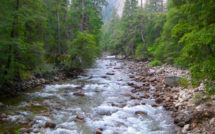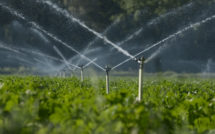

This is part of our Campus Spotlight on the Global Water Initiative at the University of Virginia.
Soaring food prices and the recent droughts in Australia, India and the United States underscore that freshwater scarcity is a major challenge in the 21st century. Almost one-fifth of the world’s population currently suffers the consequences of water scarcity, and this number is about to increase. In spite of reports about imminent water crises, the world as a whole is not running out of water. It is especially the very uneven distribution of available water across countries and regions that is a concern. Population growth, pollution, rising standards of living and changing diets and lifestyles are all bound to increase the demand for water in many parts of the world, straining the locally available water resources. In addition, climate change will make matters worse in many water-scarce areas, giving way to social disruptions, ecological damage and regional tensions.
Structure of the Class
In The Global Economics of Water we study water from an economic perspective. We link key macro and micro economic concepts to water use and water scarcity across the world. We argue that the global economy can provide answers to local water scarcity, when it gives way to more efficient water use and when local solutions can be applied across the globe. Our economic perspective complements the prevailing engineering, environmental science and hydrological approach to studying water. An alternative way to look at the course is to see it as an opportunity to learn more economics while learning about water, as we study key micro (and macro) economic concepts (comparative advantage, natural monopoly, Coase Theorem, open access resource, tragedy of the commons, etc.).
The class has four modules. We first focus on the global context of water and water use and the impact of climate change. The second module zooms in on public policy. We first tackle the public supply of water, before studying water markets as an increasingly popular tool to fight water scarcity. In the third module, we specifically put corporations and NGOs at the center of the analysis, and look at how they try to curb water use. Finally, the fourth module consists of group projects, focusing on desalination, corporate social responsibility and investing in water.
The course uses different types of materials. Next to the usual cases and visual materials (documentary, online clips) that support Darden-style case discussions, there are also a few more technical classes (on climate change, on water markets II) that are meant to make sure the analytics and/or the more technical background are understood. I have invited a few quest speakers for specific classes.
Useful Water Sites/ Sources:
The Pacific Institute (Peter Gleick) http://pacinst.org/
Access to general water data: http://worldwater.org/
Water Footprint page (Hoekstra) : http://www.waterfootprint.org/?page=files/home
FAO water http://www.fao.org/nr/water/
FAO data http://www.fao.org/nr/water/infores_databases.html
FAO Aquastat http://www.fao.org/nr/water/aquastat/main/index.stm
The World Bank Water http://www.worldbank.org/en/topic/water
Global Water Initiative at University of Virginia: https://www.darden.virginia.edu/global-water-initiative/ and blog https://blogs.darden.virginia.edu/globalwater/ (sign in, fil out strip on right)
Module 1: Global Context
1. Water Wars
Case: Water Wars? Tension in the Nile Basin, Darden Business Publishing, UVA-GEM-162 (With Selcen Cakir)
Assignment Questions:
Answer Questions at the end of the case
Optional:
Documentary (1,5 hrs): Last Call at the Oasis, Documentary by Jessica Yu, 2012.
Direct streaming link (students off-grounds need to use VPN)
http://mbaportal.darden.virginia.edu/dts/dmedia/Shared%20Documents/Video%20Assignments/LastCall.html
2. Saudi Arabia: Water Scarcity and Desalination
Case: Saudi Arabia: Water for Oil, Darden Business Publishing, – UVA-GEM- 0129
Additional Material:
Desalination plant Al Khafji
http://www.bing.com/videos/search?q=youtube+profile+saudi+arabia+desalination&FORM=VIRE5#view=detail&mid=42A6F90E826DD721754A42A6F90E826DD721754A
Desalination: Water from Water
http://www.bing.com/videos/search?q=youtube+profile+saudi+arabia+desalination&FORM=VIRE1#view=detail&mid=C86564C73304775B7422C86564C73304775B7422
Assignment Questions: Answer questions at the end of the case.
3. Singapore Take I: Water self-sufficiency
Water Self-sufficiency, the Singapore way – Youtube clips and interviews with Prime Minister on self-sufficiency and water policy (4 min clip)
Toilet to Tap Water: How Singapore became water self-sufficient (4 min clip).
Interview with Prime Minister Lee (5 parts of 8 min each)
How Much Water Do We Really Use? A Case Study of the City State of Singapore by D. Vanham, Water Science & Technology: Water Supply Vol 11 No 2 pp 219–228.Water
Assignment Questions:
1) Why is self-sufficiency so important for Singapore?
2) How has Singapore achieved water self-sufficiency?
3) What is Vanham’s take on Water self-sufficiency?
4) What is your own water footprint?
Use Water Footprint Calculator: http://www.h2oconserve.org/?page_id=503
Read the water food print section that comes with the calculator: What is grey, blue, green water? What is the difference between water consumption and water withdrawal? What is the difference between direct and indirect water use?
5) What lessons do you draw from a water footprint study like Vanham’s?
4. Singapore Take II: Trade in Services
Case: Singapore’s Trade in Services – Harvard Case 9-796-135
Technote: Why Countries Trade, the Theory of Comparative Advantage, Darden Business Publishing,–UVA-G-594
Global Water Forum, UNESCO, Dec. 20 2017, Optimizing Water Use on a Global Scale.
Optional:
The Global Economics of Water: Is Water a Source of Comparative Advantage?, American Economic Journal: Applied Economics, 2014, April, p. P. 32-48
Assignment Questions:
1) What challenges does Singapore face?
2) Outsourcing has been controversial in the United States ever since Greg Mankiw, head of the Council of Economic Advisors under President Bush, wrote an Op Ed piece in the NYTimes in 2014 in which he characterized outsourcing as a potentially positive development. It created quite a controversy that resonates till today in the critical attitude towards trade. Jagdish Baghwati refers to it in his “Why your job is not going to Bangalore,” which retains some of its relevance today.
http://query.nytimes.com/gst/fullpage.html?res=9D0DE1D81E3AF936A25751C0A9629C8B63
In light of this controversy, how would you characterize Singapore’s strategy?
Hand-in Assignment 1: Answer question 2 of the Assignment Questions.
5. Water Cycle and Climate Change
Case: Isaac Held, Lecture (35 min), Water Vapor, the Hydrological Cycle and Climate Change, Radcliffe Institute, Harvard. + document with Held’s key graph.
http://www.bing.com/videos/search?q=Isaac+Held+lecture+water+vapor&&view=detail&mid=84F8E0801DCD1AD3100684F8E0801DCD1AD31006&FORM=VRDGAR
Technote: The Water Cycle, Climate Change and (some of) their Interactions, Darden Business Publishing, UVA GEM-118 (with Paolo D’Odorico).
Optional: A changing climate means extreme rainfall but not necessarily more water, Global Water Initiative Blog.
Assignment questions:
1. What does R=P- E mean?
2. How does the greenhouse gas effect work?
3. How will climate change affect the distribution of precipitation and evaporation across the earth’s latitudes according to Dr. Isaac Held?
4. Why does it matter whether the tropical rain belt moves more south or not?
Module II Public Policy
6. Public Water Provision
Guest Speaker, Chandler Brenneman (MBA 2015), Aqua America, Philadelphia
Technote: Public Water Provision, Darden Business Publishing, – UVA-GEM 0120
Water DC gives water a makeover, Ideas to Action (with Kristin Kloberdanz)
Optional:
Richter, et al, 2013, Tapped out: growing cities in search of the next oasis. Water Policy, 15(2013), 335–363.
Case: DC Water: Water for Life, Darden Business Publishing,- UVA-GEM-151 (with George Hawkins)
Assignment Questions: Read the technote carefully, google Aqua America
7. Access to Safe Water
Case: Deadly Wells in Bangladesh, Darden Business Publishing, – UVA – GEM-158
Targeting Safe Wells in Bangladesh: https://vimeo.com/11858058
Q&A with Lex Van Geen, Global Water Initiative Blog
Assignment Questions: See questions at the end of the case
8. Water Markets I: Australia’s Drought
Case: The Big Dry and Australia’s Water Markets, Darden Business Publishing, UVA-GEM-0109
Technote: Water Markets from an Economic Point of View, Darden Business Publishing, UVA-GEM-0110
Optional:
Debaere and Kuerzendoerfer, Decomposing U.S Water Withdrawal since 1950, Journal
of the Association of Environmental and Resource Economists (JAERE), March 2017, 155- 196.
Assignment Questions: See questions at the end of the case
9. Water Markets II
Case: Anderson, Brandon, Scarborough & Lawrence, 2012, Tapping Water Markets,
Chapter 3, Who owns the water? Routledge
The Challenge of raising water productivity, Global Water Initiative Blog
Optional
Debaere et al, 2014, Water Markets as a Response to Scarcity, Water Policy, Vol 16 No 4 pp 625–649
Assignment questions:
1. Who owns water rights? Why do water rights have to be well defined?
2. Compare riparian, prior appropriation and regulated riparianism?
3. The Coase Theorem states that the initial distribution of property rights (who owns the water rights and how many) does not matter for the eventual efficient allocation of water that a water market will reach in a world without frictions (full information, no uncertainty and no transaction costs). Convince yourself that this is true using Figure 2 from the Technical note on water markets (UVA-GEM110). Convince yourself that with transaction costs, this result does not hold.
Hand-in Assignment 2: Submit answer to question 3 – graph plus explanation. You can work in groups of max 5 — You only have to submit one write-up per group. Do list explicitly the names of the people in your group.
Module III Corporations and NGOs
10. Drip Irrigation
Case: NaanDanJain: Every Drop Counts, Drip Irrigation and the Fight Against Water Scarcity, Darden Business Publishing, UVA – GEM – 122 (with Alison Elias)
Assignment Questions: See questions at the end of the case
11. Coke and WWF
Case: World Wildlife Fund and The Coca-Cola Company: A Global Partnership for Freshwater Conservation, Darden Business Publishing, – UVA- 7049
Technote: The Economics of Corporate Social Responsibility, Darden Business Publishing, UVA-GEM-143 (with Jay Shimshack)
TED- Talk Jason Clay, How Big Brands Can Save Biodversity
Assignment Question:
1. What is your assessment of WWF’s “Principles of Corporate Engagement”? What do you particularly like? Dislike? Is anything missing? Why has WWF chosen not to serve companies in a consulting capacity?
2. How would you describe TCCC’s journey with respect to its interest in and concern about the global availability of and access to freshwater? How would you assess the company’s response to its freshwater concerns?
3. What is your assessment of Jason Clay’s “Market Transformation Initiative”?
4. As Suzanne Apple, what would you recommend regarding the renewal of the agreement with TCCC? If you were Greg Koch, what would you recommend regarding the renewal of the relationship with WWF?
5. Based on the information contained in this case, what factors would you identify as critical to establishing successful and sustainable public-private partnerships to address global issues of importance to business and society?
Short Open-Book Quiz in Canvas
12. The Nature Conservancy
Guest Speaker: Brian Richter, Sustainable Waters (previously Nature Conservancy)
Case: The Nature Conservancy: Advocating for and Investing in Sustainable Water
Management, Darden Business Publishing, UVA GEM123 2014 (with Brian Richter)
Assignment Questions: see end of the case
Module IV Group Projects
13. Group Projects: Investing in Water, Challenges of Water Utility in Detroit, Water challenges in the Delhi, A few years after the Flint Water Crisis, Water ATMs in Delhi.
14. Group Projects: Corporate Social Responsibility, Water Utility in Charlottesville, Indus Water Treaty, The European Water Framework.
These are syllabi of water courses or courses with significant water content from colleagues affiliated with the Global Water Initiative at the University of Virginia.
Photo: Blue water wave | Shutterstock
Published on December 11, 2018.




